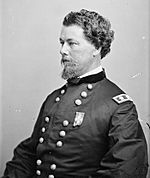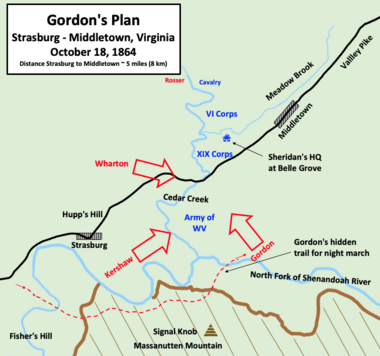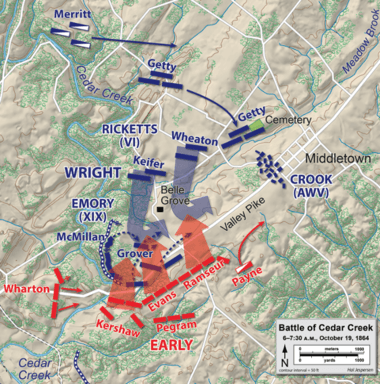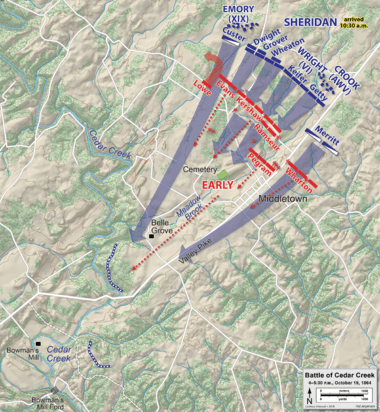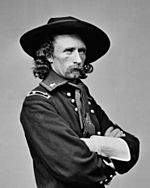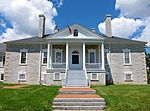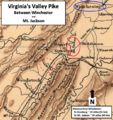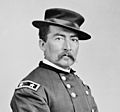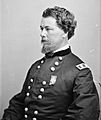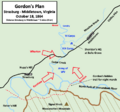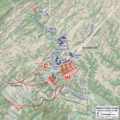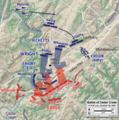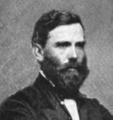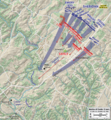Battle of Cedar Creek facts for kids
Quick facts for kids Battle of Cedar Creek(Battle of Belle Grove) |
|||||||
|---|---|---|---|---|---|---|---|
| Part of the American Civil War | |||||||
 Battle of Cedar Creek, by Kurz & Allison (1890) |
|||||||
|
|||||||
| Belligerents | |||||||
| Commanders and leaders | |||||||
| Philip Sheridan * Horatio Wright * William H. Emory * George Crook * Alfred T.A. Torbert |
Jubal Early * John Gordon * Stephen D. Ramseur † * Joseph B. Kershaw * Gabriel C. Wharton |
||||||
| Units involved | |||||||
| Army of the Shenandoah * VI Corps * XIX Corps * Army of West Virginia * Cavalry Corps |
Army of the Valley | ||||||
| Strength | |||||||
| 31,610 | 21,102 | ||||||
| Casualties and losses | |||||||
5,665
|
2,910
|
||||||
The Battle of Cedar Creek, also called the Battle of Belle Grove, happened on October 19, 1864. It was a major fight during the American Civil War. The battle took place in the Shenandoah Valley of Northern Virginia, near Cedar Creek and Middletown.
In the morning, Jubal Early, a Confederate general, seemed to be winning. His army captured over 1,000 Union soldiers and more than 20 cannons. Seven Union divisions were forced to retreat. However, the Union army, led by Philip Sheridan, fought back in the afternoon. They drove Early's soldiers away. Sheridan's forces not only got their own cannons back but also captured most of Early's cannons and supply wagons.
Early's attack began before sunrise in heavy fog. Many Union soldiers were still sleeping and were completely surprised. Early's smaller army attacked parts of the Union army from different sides. This gave him a temporary advantage. Around 10:00 AM, Early stopped his attack to get his troops organized. General Sheridan, who was returning from a meeting in Washington, D.C., arrived at the battlefield around 10:30 AM. His arrival gave his retreating army new energy. At 4:00 PM, his army counterattacked. They used their strong cavalry (soldiers on horseback). Early's army was completely defeated and ran south.
This battle destroyed the Confederate army in the Shenandoah Valley. They could no longer threaten Washington, D.C., or the northern states. The Shenandoah Valley was also a key place for getting supplies for the Confederate army. After this battle, Early could no longer protect it. The Union victory helped Abraham Lincoln win the presidential election again. This win, along with earlier victories at Winchester and Fisher's Hill, made Sheridan very famous.
Contents
How the Battle Started
Union and Confederate Plans for Virginia
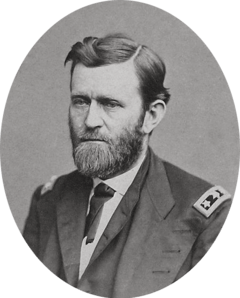
In March 1864, Ulysses S. Grant became the commander of all Union armies. Grant's plan was different from earlier generals. He wanted Union armies to work together to destroy Confederate armies, not just capture land. He used many Union forces at once. This made it hard for the Confederates to move their soldiers to different battle areas.
In Virginia, Robert E. Lee's Army of Northern Virginia was a main target. Grant wanted to cut off its supplies from Virginia's Shenandoah Valley. These supplies often moved on railroads, which also became targets.
The Confederate Army of the Valley was led by Jubal Early. Its job was to protect the Shenandoah Valley. This valley was a major source of food for Lee's army. Another goal was to threaten Washington, D.C. This would force the Union to send soldiers away from the fighting near Richmond. In June 1864, Early won battles at Lynchburg and Kernstown. In July, he threatened Washington, D.C., but was stopped.
Sheridan's Campaign in the Valley
After a Confederate cavalry raid burned a town in Pennsylvania, Grant decided Early's threat had to end. In early August, Grant put four military groups together. Philip Sheridan took command on August 7. His force was called the Army of the Shenandoah.
This army had three main goals. First, push Early's army out of the northern Shenandoah Valley. Second, destroy the valley's ability to provide food and supplies to the Confederates. Third, damage the Virginia Central Railroad.
Sheridan was careful at first. He worried that a military loss could hurt President Abraham Lincoln's chance to be re-elected. In September, Sheridan won big victories over Early at Winchester and Fisher's Hill. Sheridan then controlled the Shenandoah Valley far south. He thought Early's army was no longer a threat.
With Early weaker, Sheridan focused on destroying supplies. Sheridan's army burned crops, barns, mills, and factories. This was done mostly from September 26 to October 8. Locals called it "the Burning" or "Red October." Sheridan said that after this, "the Valley... will have but little in it for man or beast."
Early Gets More Soldiers
After Early's defeat at Fisher's Hill on September 22, he moved south. On September 26, he got more infantry soldiers. More help arrived on October 5 with a cavalry brigade led by Thomas L. Rosser. Early believed these new soldiers made up for his losses.
After "the Burning," Sheridan's cavalry began moving north. Confederate cavalry tried to bother Sheridan's rear guard. On October 9, in the Battle of Tom's Brook, Union generals George Custer and Wesley Merritt completely defeated the Confederate cavalry.
Armies and Leaders
Union Forces
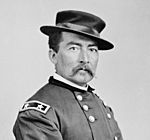
In mid-October, the Union Army of the Shenandoah had about 31,610 soldiers and 90 cannons. A few days before the battle, Sheridan went to Washington. Horatio Wright commanded the army while Sheridan was away.
The Union forces were:
- The VI Corps: About 8,500 infantry and 600 artillerymen with 24 cannons. They were known for being steady and reliable.
- The XIX Corps: About 8,700 infantry and 400 artillerymen with 20 cannons.
- The Cavalry Corps: About 7,500 cavalrymen and 642 artillerymen with 30 cannons. Many of their soldiers had fast-firing repeating rifles.
- The Army of West Virginia: About 4,000 infantry and 200 artillerymen with 16 cannons. This was a smaller force.
Confederate Forces
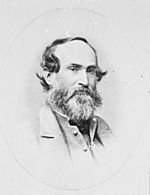
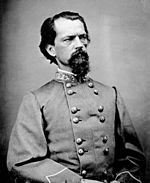
Early's Confederate Army of the Valley had about 21,102 soldiers. This included over 3,000 men from Joseph B. Kershaw's infantry division and 2,206 men from Rosser's cavalry.
The Confederate forces were:
- Infantry: Five divisions led by generals like Stephen Dodson Ramseur and John Brown Gordon. Gordon was Early's second-in-command.
- Cavalry: Two divisions. One was led by Lunsford L. Lomax, whose men fought more like infantry on foot. The other was led by Rosser, known as an aggressive cavalry commander.
Moving to Battle
Sheridan Thinks the Fight is Over
After the big win at Tom's Brook, Sheridan and many Union soldiers thought the fight against Early was finished. The Union army began moving north, expecting to fight somewhere else. Some Union soldiers camped near Cedar Creek and Middletown. Other soldiers were further away.
Grant still wanted the Confederate Virginia Central Railroad destroyed. So, some cavalry were sent south to attack the railroad lines. On October 12, the VI Corps was ordered to leave for Alexandria, Virginia. Sheridan planned to send them to help Grant's main army.
A Small Fight and Sheridan's Trip
Hidden from Sheridan's army, Early's troops arrived near Strasburg on October 13. They started shelling the Union camp. This was a surprise. A small fight happened, and both sides had some casualties. Sheridan called the VI Corps back as a safety measure. This was a mistake for Early, as these 9,000 experienced soldiers made a big difference later.
On October 13, the Secretary of War asked Sheridan to come to Washington. They wanted Sheridan to move his army to attack Confederate railroads. Sheridan kept saying it would be too hard to move his army there. Since the small fight was over, Sheridan left for Washington on October 15. He left General Wright in charge. Sheridan ordered his cavalry to go with him at first, planning to send them to destroy a railroad bridge. But then he heard false rumors that more Confederate troops were coming. So, Sheridan sent his cavalry back to the camps near Cedar Creek. Sheridan arrived in Washington on October 17.
Gordon's Secret Plan
On October 17, General Gordon climbed a mountain. He saw that the Union army's left side was weak. He thought the Union soldiers were relying too much on the mountain and rivers for defense. Gordon convinced Early to attack the Union's left side. He believed they could destroy Sheridan's army.
Early agreed, but only if Gordon could find a hidden path to get around the Union left. The next day, Gordon found a narrow trail. Early approved the attack, which would start on the morning of October 19.
The attack would happen before dawn, using the morning fog for cover. Gordon would lead three divisions in a surprise attack from behind the Union left. Another Confederate division would attack from the front. Other Confederate soldiers and cannons would attack down the main road. Confederate cavalry would try to stop Union cavalry from helping. Gordon's force had to leave on the evening of October 18 to be in place by dawn. A small cavalry group would try to capture Sheridan at his headquarters. Another cavalry group would try to cut off the Union retreat. The Confederate leaders set their watches to attack at 5:00 AM.
The Battle Unfolds
The Surprise Attack
Early's infantry began forming their attack groups on the evening of October 18. Gordon's group had the longest march. They left around 8:00 PM in the dark. The soldiers removed anything that might make noise. They followed the narrow trail in a single line. The other two Confederate groups left around 1:00 AM on October 19. Early rode with one of these groups. As they hoped, the heavy fog helped hide their quiet approach. All three groups were in position by 3:30 AM. The two Confederate cavalry groups were also in place.
Union Soldiers Caught Off Guard
Around 5:00 AM, Confederate soldiers attacked the Union trenches. The surprise was almost complete. Most of the Union soldiers were caught unprepared in their camps. Many were still sleeping in their tents. One Union division lost most of its organization as soldiers fled. Some Union officers tried to keep their men fighting as they retreated. One Union captain saved nine of his sixteen cannons while fighting his way back.
Another Union division was attacked by seven Confederate brigades. Many of these Union soldiers were also still in their tents. Soon, they too were retreating. Some Union soldiers fled towards the Belle Grove Plantation house. Others ran northeast down the main road. Further north, a Union division of new recruits fled quickly.
Unlike the first Union groups, the Union XIX Corps was not completely surprised. They heard the sounds of fighting and got ready. They were attacked from the south and east by Confederate troops.
A small group of Union soldiers held their position for about 40 minutes. This allowed most of the Union headquarters and supply wagons to escape safely. In about two hours, Early had pushed back five Union divisions. He captured over 1,300 prisoners and 18 cannons. Many Union soldiers were running away in confusion. The Union VI Corps prepared to defend on some ridges further north.
Early's Decision to Pause
Between 7:00 and 7:30 AM, Early met Gordon. Early believed he had won a great victory. He saw that two Union corps were completely defeated. He also saw that the Union VI Corps was in a strong defensive position. Early took over command. Gordon wanted to keep attacking the VI Corps right away. But Early decided to stop his attack to reorganize his troops. This decision later caused him much criticism.

The Union VI Corps commander had his men ready within 20 minutes of the attack. They were pulled back to a strong defensive spot. Confederates attacked them around 7:30 AM. The Union divisions were pushed back. One Union general, George W. Getty, became the only organized Union infantry south of Middletown. For over an hour, Getty's division defended its position against Confederate attacks. After a while, Getty's division moved back about one mile, where they found support from Union cavalry.
Sheridan's Famous Ride
The Union cavalry divisions were north of the infantry when the Confederate attack began. The Confederate cavalry seemed hesitant and did not attack strongly. The Union cavalry commanders sent some of their men to the main road. They tried to stop Union infantry soldiers from running away. Between 9:00 AM and 10:00 AM, the Union cavalry moved to the west side of the main road. They faced heavy cannon fire but stopped Early from getting behind the Union army.
Sheridan had spent the night in Winchester. At 6:00 AM, he heard distant sounds of cannons. He thought it was just a small scouting mission. But as more reports came in, he ordered his horses ready. By 9:00 AM, he was riding south. Sheridan realized his army was retreating towards him. He met retreating soldiers and wagons less than two miles south of Winchester. He heard panicked stories that all was lost. He ordered a line of soldiers to stop the stragglers.
Sheridan arrived around 10:30 AM. He began to rally his men to complete the defensive line. His presence greatly inspired his soldiers. One soldier said it was like an "electric shock."
Early's Pause and the Union Counterattack
By 10:00 AM, Early thought he had won. He had captured many Union prisoners and cannons. He had driven seven Union divisions off the field. When Early rode into Middletown, he saw that the Confederate attack had stopped. It was held back by Union cannons and cavalry. Early ordered a halt to his attack to reorganize. This decision was criticized later.
Gordon wanted to attack the Union VI Corps right away. He later wrote that the "fatal halting" turned a great victory into a disaster. Early's main reason for stopping was concern about the Union cavalry, which had repeating rifles. Another problem was that many hungry Confederate soldiers had stopped to take things from the abandoned Union camps. By 11:30 AM, the Confederate line was ready to attack again. Early attacked with three divisions. But after moving about half a mile, the attack stopped again at 1:00 PM. Early's reasons were the same: Union cavalry, missing soldiers who were looting, and tired, hungry soldiers.
The Union Fights Back
When Sheridan arrived at 10:30 AM, he thought a large Confederate force might be coming from another direction. After questioning prisoners, he learned this was not true. Once Sheridan was sure (around 3:30 PM) that no other Confederate forces were nearby, he ordered an attack.
The Union counterattack began just before 4:00 PM. Custer's cavalry was on the far right. Merritt's cavalry was on the left. The Union infantry was in the middle. Sheridan's plan was for his cavalry to hold the Confederate sides. The infantry would push the Confederate left flank and drive them away from the main road. This would stop Early's army from using the bridge over Cedar Creek to escape.
The Union infantry attack struggled at first. They could not push the Confederates back easily. Confederates were behind stone walls and had cannon support. On the Union left, Merritt's cavalry charged twice but was pushed back. On Merritt's third charge, with the infantry moving forward, the Confederate troops finally broke and ran.
Custer's Final Push
On the far Union right, Custer's cavalry was fighting. Custer left some of his men and took the rest of his division towards the main infantry attack. He wanted to get behind Early's men and capture the main road bridge over Cedar Creek. This would cut off the Confederate escape route.
Many Confederate soldiers saw Union cavalry moving towards their escape path. They began to panic and retreat. Custer's appearance helped the Union infantry attack again. The remaining Confederate soldiers, already panicked, faced a renewed attack. Soon, most of them fled towards the main road. This caused a chain reaction, and other Confederate divisions also broke. During this time, Confederate General Ramseur was badly wounded and captured.
While Custer was on the Union right, Merritt's cavalry was on the Union left. Merritt's men captured the Cedar Creek bridge first. So, Custer took his two lead regiments to the right of the bridge. They crossed the creek and kept chasing the fleeing enemy south.
Around 5:30 PM, the last Confederate units crossed Cedar Creek. The fields were full of fleeing men, wagons, and cannons. Union cavalry chased them, using sabers. The situation got worse for the Confederates when a small bridge south of Strasburg collapsed. This made it impossible to cross with wagons or cannons. Early's army had to leave behind all the Union cannons and wagons they captured that morning. They also lost most of their own. Sheridan's chase ended when night fell. The retreating Confederate soldiers gathered temporarily on Fisher's Hill. They moved further south before dawn the next day.
Battle Losses
The Union army had 644 soldiers killed, 3,430 wounded, and 1,591 captured or missing. This was a total of 5,665 casualties. Two Union division commanders were killed or badly wounded. Two Union brigade commanders were also killed.
Confederate losses are less certain. It is thought they had 320 killed, 1,540 wounded, and 1,050 missing or captured. This totals 2,910, which is much less than the Union losses. The Confederates also lost 300 wagons and ambulances. They lost 43 cannons, including the 20 Union cannons they captured in the morning. The highest-ranking Confederate lost was General Ramseur, who was badly wounded and captured.
What Happened After
Impact of the Battle
Three things helped the Confederates succeed at first. First, many Union soldiers thought the fighting was over. This made them less watchful. Second, the land and poor placement of Union troops allowed the Confederates to surprise and outnumber them. Third, Union cavalry was in the wrong place, leaving the left side open. Once the Union cavalry was used, they played a key role in the Union victory. Cavalry soldiers won nearly half of the Medals of Honor at Cedar Creek.
Many people gave Sheridan credit for the Union victory. He was featured on the cover of a popular magazine. It is clear that Sheridan's arrival greatly inspired his men. Others believe General Wright deserves much credit. His VI Corps stopped the Confederate attack. Wright's decisions helped Sheridan rally his men.
Some credit for the Union victory can also be given to Confederate leader Jubal Early. His early morning attack was well-planned and a total surprise. But Early's cavalry was divided and poorly placed. The Confederate army's inactivity after 10:00 AM allowed the Union army to reorganize and win. Gordon, who planned the early attack, blamed Early for stopping the attack. Early claimed that too many of Gordon's soldiers stopped to loot the Union camps. This, plus the threat of Union cavalry, caused the pause.
Sheridan's victories in the Shenandoah Valley helped President Lincoln win his re-election in November. Lincoln was very happy with the victory at Cedar Creek. It happened three weeks before the presidential election. Sheridan became instantly famous. A popular poem, Sheridan's Ride, added to his fame. Sheridan's success made him one of the most important generals. An equestrian statue of Sheridan stands in Washington, D.C.
In contrast, Early's status dropped a lot. He was accused of not being good at his job. Parts of his army were called back to Richmond. On March 2, 1865, Early and what was left of his army were defeated. The Army of the Valley stopped existing. Early escaped, but his cannons, wagons, and equipment were captured. His men were captured, killed, or scattered.
Preserving the Battlefield
Parts of the Cedar Creek battlefield are now preserved. They are part of the Cedar Creek and Belle Grove National Historical Park. This park was created in 2002. The park covers about 3,700 acres. It has trails, exhibits, and the Belle Grove Plantation Manor House. Belle Grove was built in the 1790s. It is an important historical landmark.
Images for kids




